Junjie Zhou
OmniGen2: Exploration to Advanced Multimodal Generation
Jun 23, 2025Abstract:In this work, we introduce OmniGen2, a versatile and open-source generative model designed to provide a unified solution for diverse generation tasks, including text-to-image, image editing, and in-context generation. Unlike OmniGen v1, OmniGen2 features two distinct decoding pathways for text and image modalities, utilizing unshared parameters and a decoupled image tokenizer. This design enables OmniGen2 to build upon existing multimodal understanding models without the need to re-adapt VAE inputs, thereby preserving the original text generation capabilities. To facilitate the training of OmniGen2, we developed comprehensive data construction pipelines, encompassing image editing and in-context generation data. Additionally, we introduce a reflection mechanism tailored for image generation tasks and curate a dedicated reflection dataset based on OmniGen2. Despite its relatively modest parameter size, OmniGen2 achieves competitive results on multiple task benchmarks, including text-to-image and image editing. To further evaluate in-context generation, also referred to as subject-driven tasks, we introduce a new benchmark named OmniContext. OmniGen2 achieves state-of-the-art performance among open-source models in terms of consistency. We will release our models, training code, datasets, and data construction pipeline to support future research in this field. Project Page: https://vectorspacelab.github.io/OmniGen2; GitHub Link: https://github.com/VectorSpaceLab/OmniGen2
VideoDeepResearch: Long Video Understanding With Agentic Tool Using
Jun 12, 2025Abstract:Long video understanding (LVU) presents a significant challenge for current multi-modal large language models (MLLMs) due to the task's inherent complexity and context window constraint. It is widely assumed that addressing LVU tasks requires foundation MLLMs with extended context windows, strong visual perception capabilities, and proficient domain expertise. In this work, we challenge this common belief by introducing VideoDeepResearch, a novel agentic framework for long video understanding. Our approach relies solely on a text-only large reasoning model (LRM) combined with a modular multi-modal toolkit, including multimodal retrievers and visual perceivers, all of which are readily available in practice. For each LVU task, the system formulates a problem-solving strategy through reasoning, while selectively accessing and utilizing essential video content via tool using. We conduct extensive experiments on popular LVU benchmarks, including MLVU, Video-MME, and LVBench. Our results demonstrate that VideoDeepResearch achieves substantial improvements over existing MLLM baselines, surpassing the previous state-of-the-art by 9.6%, 6.6%, and 3.9% on MLVU (test), LVBench, and LongVideoBench, respectively. These findings highlight the promise of agentic systems in overcoming key challenges in LVU problems.
Feature Fusion Revisited: Multimodal CTR Prediction for MMCTR Challenge
Apr 26, 2025Abstract:With the rapid advancement of Multimodal Large Language Models (MLLMs), an increasing number of researchers are exploring their application in recommendation systems. However, the high latency associated with large models presents a significant challenge for such use cases. The EReL@MIR workshop provided a valuable opportunity to experiment with various approaches aimed at improving the efficiency of multimodal representation learning for information retrieval tasks. As part of the competition's requirements, participants were mandated to submit a technical report detailing their methodologies and findings. Our team was honored to receive the award for Task 2 - Winner (Multimodal CTR Prediction). In this technical report, we present our methods and key findings. Additionally, we propose several directions for future work, particularly focusing on how to effectively integrate recommendation signals into multimodal representations. The codebase for our implementation is publicly available at: https://github.com/Lattice-zjj/MMCTR_Code, and the trained model weights can be accessed at: https://huggingface.co/FireFlyCourageous/MMCTR_DIN_MicroLens_1M_x1.
DAMM-Diffusion: Learning Divergence-Aware Multi-Modal Diffusion Model for Nanoparticles Distribution Prediction
Mar 12, 2025



Abstract:The prediction of nanoparticles (NPs) distribution is crucial for the diagnosis and treatment of tumors. Recent studies indicate that the heterogeneity of tumor microenvironment (TME) highly affects the distribution of NPs across tumors. Hence, it has become a research hotspot to generate the NPs distribution by the aid of multi-modal TME components. However, the distribution divergence among multi-modal TME components may cause side effects i.e., the best uni-modal model may outperform the joint generative model. To address the above issues, we propose a \textbf{D}ivergence-\textbf{A}ware \textbf{M}ulti-\textbf{M}odal \textbf{Diffusion} model (i.e., \textbf{DAMM-Diffusion}) to adaptively generate the prediction results from uni-modal and multi-modal branches in a unified network. In detail, the uni-modal branch is composed of the U-Net architecture while the multi-modal branch extends it by introducing two novel fusion modules i.e., Multi-Modal Fusion Module (MMFM) and Uncertainty-Aware Fusion Module (UAFM). Specifically, the MMFM is proposed to fuse features from multiple modalities, while the UAFM module is introduced to learn the uncertainty map for cross-attention computation. Following the individual prediction results from each branch, the Divergence-Aware Multi-Modal Predictor (DAMMP) module is proposed to assess the consistency of multi-modal data with the uncertainty map, which determines whether the final prediction results come from multi-modal or uni-modal predictions. We predict the NPs distribution given the TME components of tumor vessels and cell nuclei, and the experimental results show that DAMM-Diffusion can generate the distribution of NPs with higher accuracy than the comparing methods. Additional results on the multi-modal brain image synthesis task further validate the effectiveness of the proposed method.
Robust Multimodal Survival Prediction with the Latent Differentiation Conditional Variational AutoEncoder
Mar 12, 2025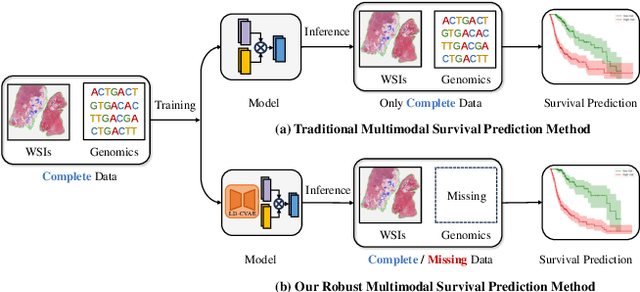

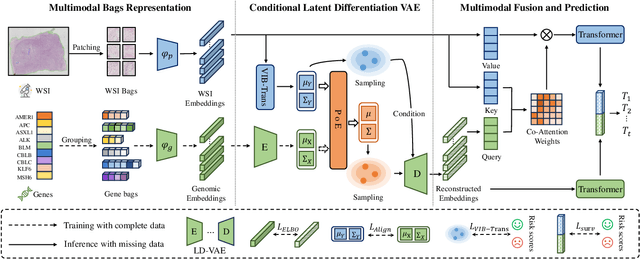

Abstract:The integrative analysis of histopathological images and genomic data has received increasing attention for survival prediction of human cancers. However, the existing studies always hold the assumption that full modalities are available. As a matter of fact, the cost for collecting genomic data is high, which sometimes makes genomic data unavailable in testing samples. A common way of tackling such incompleteness is to generate the genomic representations from the pathology images. Nevertheless, such strategy still faces the following two challenges: (1) The gigapixel whole slide images (WSIs) are huge and thus hard for representation. (2) It is difficult to generate the genomic embeddings with diverse function categories in a unified generative framework. To address the above challenges, we propose a Conditional Latent Differentiation Variational AutoEncoder (LD-CVAE) for robust multimodal survival prediction, even with missing genomic data. Specifically, a Variational Information Bottleneck Transformer (VIB-Trans) module is proposed to learn compressed pathological representations from the gigapixel WSIs. To generate different functional genomic features, we develop a novel Latent Differentiation Variational AutoEncoder (LD-VAE) to learn the common and specific posteriors for the genomic embeddings with diverse functions. Finally, we use the product-of-experts technique to integrate the genomic common posterior and image posterior for the joint latent distribution estimation in LD-CVAE. We test the effectiveness of our method on five different cancer datasets, and the experimental results demonstrate its superiority in both complete and missing modality scenarios.
MomentSeeker: A Comprehensive Benchmark and A Strong Baseline For Moment Retrieval Within Long Videos
Feb 18, 2025Abstract:Retrieval augmented generation (RAG) holds great promise in addressing challenges associated with long video understanding. These methods retrieve useful moments from long videos for their presented tasks, thereby enabling multimodal large language models (MLLMs) to generate high-quality answers in a cost-effective way. In this work, we present MomentSeeker, a comprehensive benchmark to evaluate retrieval models' performance in handling general long-video moment retrieval (LVMR) tasks. MomentSeeker offers three key advantages. First, it incorporates long videos of over 500 seconds on average, making it the first benchmark specialized for long-video moment retrieval. Second, it covers a wide range of task categories (including Moment Search, Caption Alignment, Image-conditioned Moment Search, and Video-conditioned Moment Search) and diverse application scenarios (e.g., sports, movies, cartoons, and ego), making it a comprehensive tool for assessing retrieval models' general LVMR performance. Additionally, the evaluation tasks are carefully curated through human annotation, ensuring the reliability of assessment. We further fine-tune an MLLM-based LVMR retriever on synthetic data, which demonstrates strong performance on our benchmark. We perform extensive experiments with various popular multimodal retrievers based on our benchmark, whose results highlight the challenges of LVMR and limitations for existing methods. Our created resources will be shared with community to advance future research in this field.
Any Information Is Just Worth One Single Screenshot: Unifying Search With Visualized Information Retrieval
Feb 17, 2025Abstract:With the popularity of multimodal techniques, it receives growing interests to acquire useful information in visual forms. In this work, we formally define an emerging IR paradigm called \textit{Visualized Information Retrieval}, or \textbf{Vis-IR}, where multimodal information, such as texts, images, tables and charts, is jointly represented by a unified visual format called \textbf{Screenshots}, for various retrieval applications. We further make three key contributions for Vis-IR. First, we create \textbf{VIRA} (Vis-IR Aggregation), a large-scale dataset comprising a vast collection of screenshots from diverse sources, carefully curated into captioned and question-answer formats. Second, we develop \textbf{UniSE} (Universal Screenshot Embeddings), a family of retrieval models that enable screenshots to query or be queried across arbitrary data modalities. Finally, we construct \textbf{MVRB} (Massive Visualized IR Benchmark), a comprehensive benchmark covering a variety of task forms and application scenarios. Through extensive evaluations on MVRB, we highlight the deficiency from existing multimodal retrievers and the substantial improvements made by UniSE. Our work will be shared with the community, laying a solid foundation for this emerging field.
MegaPairs: Massive Data Synthesis For Universal Multimodal Retrieval
Dec 19, 2024Abstract:Despite the rapidly growing demand for multimodal retrieval, progress in this field remains severely constrained by a lack of training data. In this paper, we introduce MegaPairs, a novel data synthesis method that leverages vision language models (VLMs) and open-domain images, together with a massive synthetic dataset generated from this method. Our empirical analysis shows that MegaPairs generates high-quality data, enabling the multimodal retriever to significantly outperform the baseline model trained on 70$\times$ more data from existing datasets. Moreover, since MegaPairs solely relies on general image corpora and open-source VLMs, it can be easily scaled up, enabling continuous improvements in retrieval performance. In this stage, we produced more than 26 million training instances and trained several models of varying sizes using this data. These new models achieve state-of-the-art zero-shot performance across 4 popular composed image retrieval (CIR) benchmarks and the highest overall performance on the 36 datasets provided by MMEB. They also demonstrate notable performance improvements with additional downstream fine-tuning. Our produced dataset, well-trained models, and data synthesis pipeline will be made publicly available to facilitate the future development of this field.
All You Need in Knowledge Distillation Is a Tailored Coordinate System
Dec 12, 2024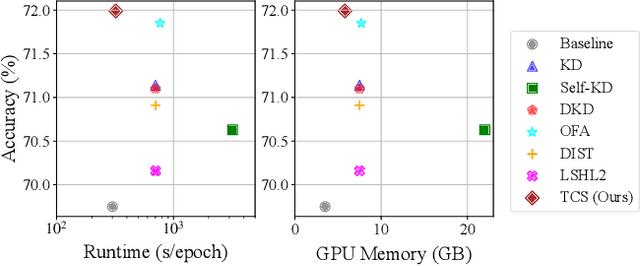

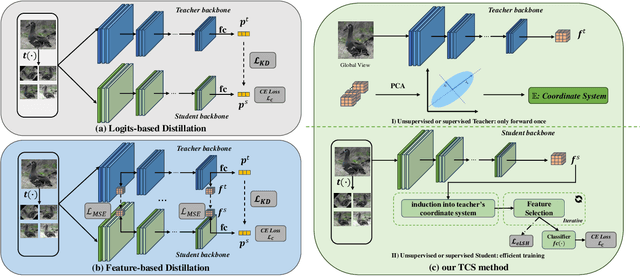
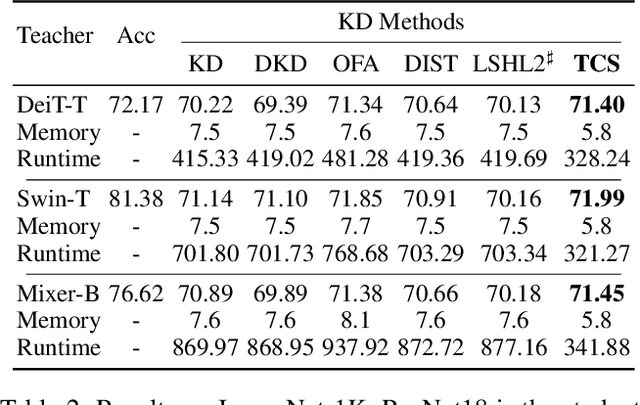
Abstract:Knowledge Distillation (KD) is essential in transferring dark knowledge from a large teacher to a small student network, such that the student can be much more efficient than the teacher but with comparable accuracy. Existing KD methods, however, rely on a large teacher trained specifically for the target task, which is both very inflexible and inefficient. In this paper, we argue that a SSL-pretrained model can effectively act as the teacher and its dark knowledge can be captured by the coordinate system or linear subspace where the features lie in. We then need only one forward pass of the teacher, and then tailor the coordinate system (TCS) for the student network. Our TCS method is teacher-free and applies to diverse architectures, works well for KD and practical few-shot learning, and allows cross-architecture distillation with large capacity gap. Experiments show that TCS achieves significantly higher accuracy than state-of-the-art KD methods, while only requiring roughly half of their training time and GPU memory costs.
Quantization without Tears
Nov 22, 2024



Abstract:Deep neural networks, while achieving remarkable success across diverse tasks, demand significant resources, including computation, GPU memory, bandwidth, storage, and energy. Network quantization, as a standard compression and acceleration technique, reduces storage costs and enables potential inference acceleration by discretizing network weights and activations into a finite set of integer values. However, current quantization methods are often complex and sensitive, requiring extensive task-specific hyperparameters, where even a single misconfiguration can impair model performance, limiting generality across different models and tasks. In this paper, we propose Quantization without Tears (QwT), a method that simultaneously achieves quantization speed, accuracy, simplicity, and generality. The key insight of QwT is to incorporate a lightweight additional structure into the quantized network to mitigate information loss during quantization. This structure consists solely of a small set of linear layers, keeping the method simple and efficient. More importantly, it provides a closed-form solution, allowing us to improve accuracy effortlessly under 2 minutes. Extensive experiments across various vision, language, and multimodal tasks demonstrate that QwT is both highly effective and versatile. In fact, our approach offers a robust solution for network quantization that combines simplicity, accuracy, and adaptability, which provides new insights for the design of novel quantization paradigms.
 Add to Chrome
Add to Chrome Add to Firefox
Add to Firefox Add to Edge
Add to Edge